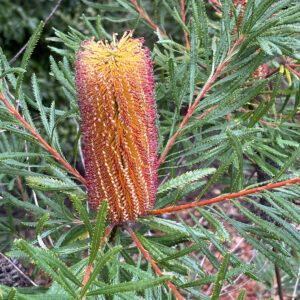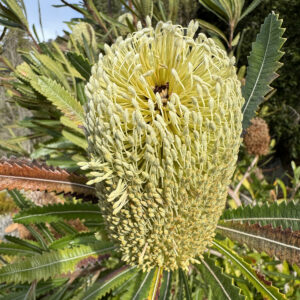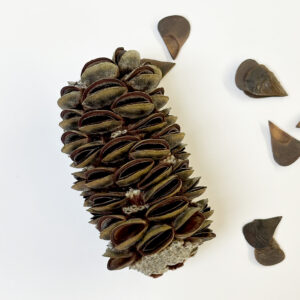
By Director Lew Feldman
The UC Botanical Garden has a small but remarkable collection of Banksia species (12 of an estimated 183 different species), many of which are now flowering in the Garden’s Australasian Area. These plants are native to Australia and New Guinea where they range in size from prostrate shrubs to trees, up to 30 meters tall (100 ft). Nearly half of the Garden’s species are from New South Wales, collected as seeds by a former horticulturist.
The genus is named after Joseph Banks, an English naturalist (1743-1820) who was a member of Captain James Cook’s round-the-world voyage (1768-1771), and who, working with the botanist Daniel Solander, first collected this plant. In 1782 the great Swedish naturalist Linnaeus honored Bank’s discovery with the name Banksia.
The flowers of Banksia are arranged into elongated heads or spikes which can be made up of hundreds or even thousands of tiny, individual flowers, which together give the impression of a rounded brush. The bottle brush analogy is made more real if you gently run your hand up and down one of the elongated flower heads, feeling the stiff, brush-like texture. (do so on your next visit to the Garden).

Hairpin banksia (Banksia spinulosa)

Saw banksia (Banksia serrata)
Individual flowers in the heads are distinguished by the presence of a long “stigma-style”, the portion of the flower to which pollen is transferred. The flower heads are also distinguished by the copious production of nectar, which is a vital part of the life cycle of both Banksia and its pollinators (that include honey possums and nectar-eating birds). When these pollinators visit the flower heads for nectar, they not only have a source of essential nutrients, but also transfer pollen to the elongated upright stigma-styles.
Most Banksia contain their seeds in protective, often woody structures that open following exposure to periodic, rapidly moving fires. In such an environment the newly germinated seedlings experience less competition for resources, such as water and light.

Banksia seed pod closed

Seed pod with seeds that has opened due to exposure to heat
